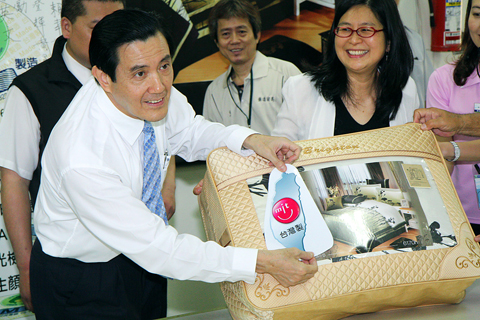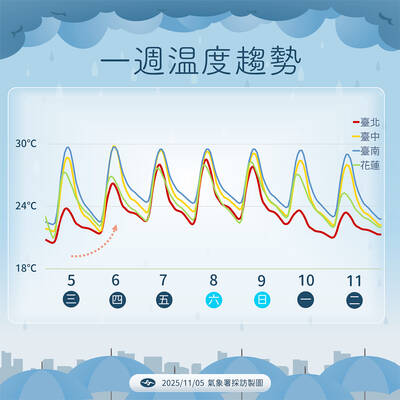President Ma Ying-jeou (馬英九) yesterday said his remark that Taiwan would “never” ask the US to fight for Taiwan in a war was made because he was confident there would be no war in the Taiwan Strait during his presidency.
Chinese Nationalist Party (KMT) spokesman Su Jun-pin (蘇俊賓) quoted Ma, who doubles as KMT chairman, as saying after the party’s closed-door Central Standing Committee meeting yesterday that he sought to turn Taiwan from a “troublemaker” to a peacemaker.
“The President has the utmost confidence in peace across the Taiwan Strait and believes that there will not be war while he is in office,” Su said. “If there is no war in the Taiwan Strait, we definitely will not ask the US to fight for Taiwan.”

PHOTO: CNA
Ma caused a stir when he said Taiwan would “never ask the Americans to fight for Taiwan” during an interview with CNN’s Christiane Amanpour last week. Ma said in the interview that the risk for the US was at its lowest in 60 years, which he credited to his administration’s efforts to improve cross-strait relations.
Su yesterday said the Ma administration would continue to procure arms from the US to protect the country’s security and to manifest its resolve to defend itself.
“We will not let our guard down and will remain prepared against war despite cross-strait detente,” Su quoted Ma as saying.
Su said Ma also said that the reason he spoke English during the interview was because translation would have taken up too much of the interview time.
Meanwhile, the Washington-based Formosan Association for Public Affairs (FAPA) criticized Ma for what it said was inviting “aggression” from China.
The group said it was “deeply concerned” about the “never” remarks made by Ma during the CNN interview.
FAPA president Bob Yang (楊英育) said Ma’s remarks were totally at odds with the basic US policy of strategic ambiguity.
Under the policy, China is meant to be left guessing at how the US would respond to an attack on Taiwan. That uncertainty was designed to act as a strong deterrent against provocative action.
“Ma’s remarks leave China with the impression that this ambiguity is removed, thereby undermining the deterrence provided by the US presence in the region,” Yang said.
In a prepared statement, Yang said: “We are clearly in favor of a peaceful resolution, but that can only be achieved if Taiwan shows the resolve to defend itself. The statement made by Ma actually invites aggression from China, which has been threatening Taiwan’s free and democratic existence for many years.
“It amounts to pre-emptive surrender by the Chinese Nationalist Kuomintang [KMT] government in Taiwan,” he said.
Yang said Ma’s remarks “fly in the face” of US commitments under the Taiwan Relations Act, which commits the US to maintain the capacity to resist any resort to force or other forms of coercion that would jeopardize the security or the social or economic system of Taiwan.
FAPA, a US-wide organization with substantial support in the Taiwanese community, believes that it is essential for Ma to issue a clarification and to state that his administration “adheres to the basic policies on which the strong relations with the US are based.”
Yang also called on Ma to “refrain from making any moves which undermine Taiwan’s freedom, democracy and independence.”

UNILATERAL MOVES: Officials have raised concerns that Beijing could try to exert economic control over Kinmen in a key development plan next year The Civil Aviation Administration (CAA) yesterday said that China has so far failed to provide any information about a new airport expected to open next year that is less than 10km from a Taiwanese airport, raising flight safety concerns. Xiamen Xiangan International Airport is only about 3km at its closest point from the islands in Kinmen County — the scene of on-off fighting during the Cold War — and construction work can be seen and heard clearly from the Taiwan side. In a written statement sent to Reuters, the CAA said that airports close to each other need detailed advanced

Tropical Storm Fung-Wong would likely strengthen into a typhoon later today as it continues moving westward across the Pacific before heading in Taiwan’s direction next week, the Central Weather Administration (CWA) said. As of 8am, Fung-Wong was about 2,190km east-southeast of Cape Oluanpi (鵝鑾鼻), Taiwan’s southernmost point, moving westward at 25kph and possibly accelerating to 31kph, CWA data showed. The tropical storm is currently over waters east of the Philippines and still far from Taiwan, CWA forecaster Tseng Chao-cheng (曾昭誠) said, adding that it could likely strengthen into a typhoon later in the day. It is forecast to reach the South China Sea

WEATHER Typhoon forming: CWA A tropical depression is expected to form into a typhoon as early as today, the Central Weather Administration (CWA) said yesterday, adding that the storm’s path remains uncertain. Before the weekend, it would move toward the Philippines, the agency said. Some time around Monday next week, it might reach a turning point, either veering north toward waters east of Taiwan or continuing westward across the Philippines, the CWA said. Meanwhile, the eye of Typhoon Kalmaegi was 1,310km south-southeast of Oluanpi (鵝鑾鼻), Taiwan’s southernmost point, as of 2am yesterday, it said. The storm is forecast to move through central

UNKNOWN TRAJECTORY: The storm could move in four possible directions, with the fourth option considered the most threatening to Taiwan, meteorologist Lin De-en said A soon-to-be-formed tropical storm east of the Philippines could begin affecting Taiwan on Wednesday next week, the Central Weather Administration (CWA) said yesterday. The storm, to be named Fung-wong (鳳凰), is forecast to approach Taiwan on Tuesday next week and could begin affecting the weather in Taiwan on Wednesday, CWA forecaster Huang En-hung (黃恩鴻) said, adding that its impact might be amplified by the combined effect with the northeast monsoon. As of 2pm yesterday, the system’s center was 2,800km southeast of Oluanbi (鵝鑾鼻). It was moving northwest at 18kph. Meteorologist Lin De-en (林得恩) on Facebook yesterday wrote that the would-be storm is surrounded by